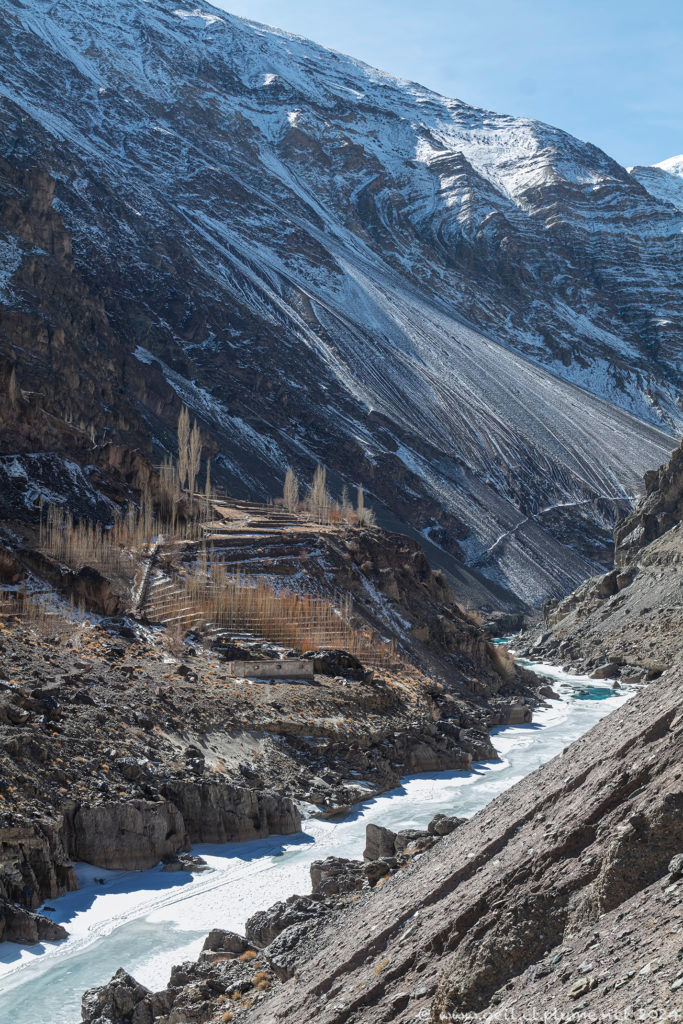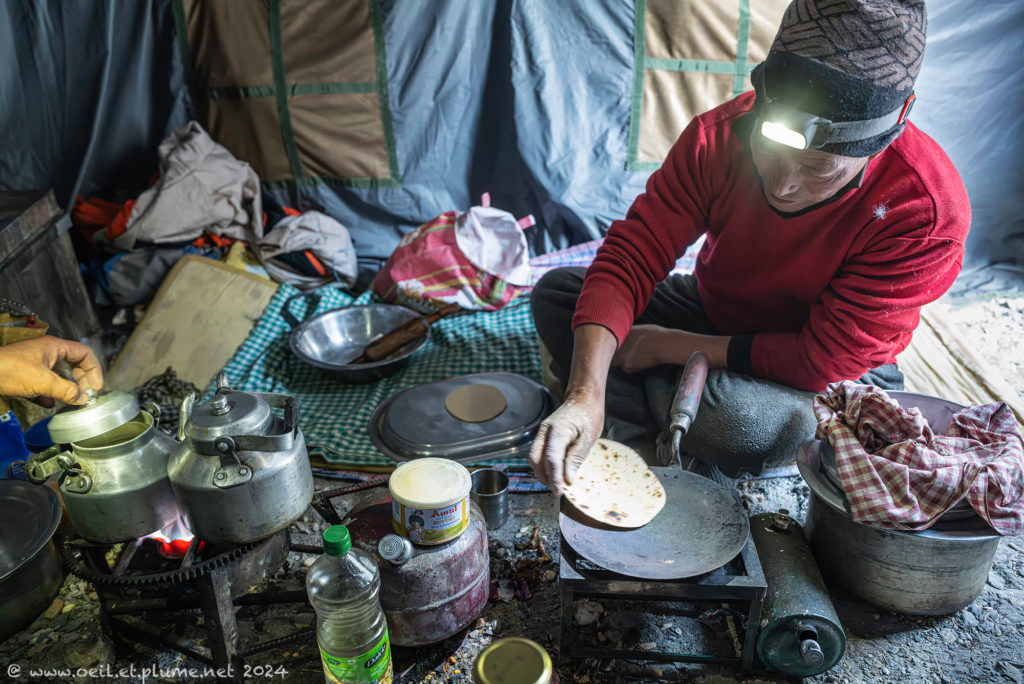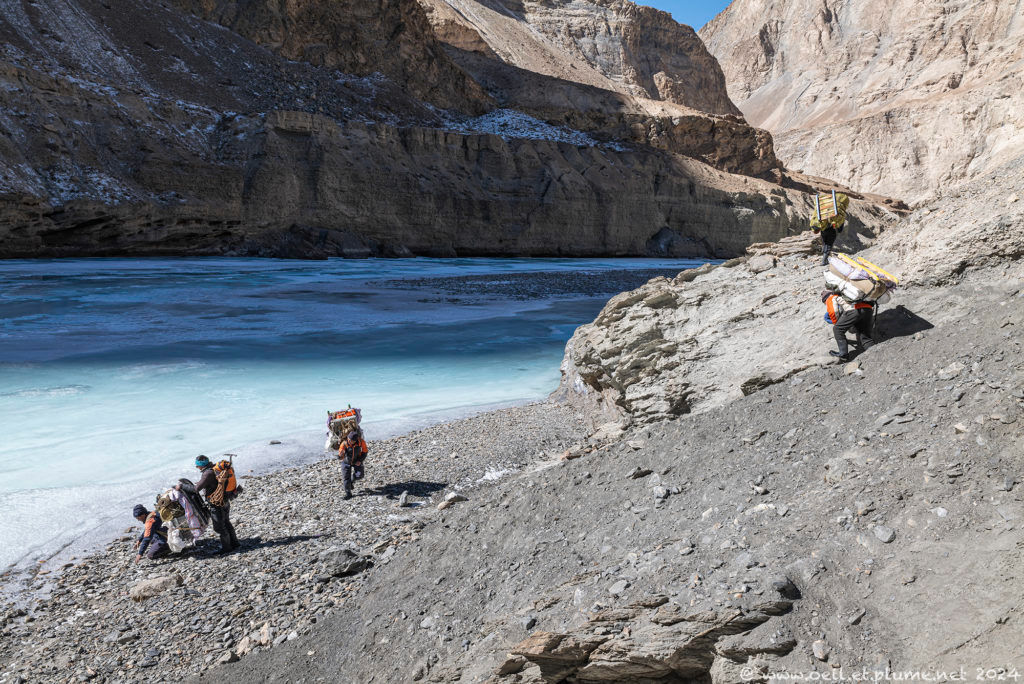Imagine a small landlocked Buddhist kingdom inserted in the Himalayas mountain range. During the long and harsh winter period, the local population was cut from the rest of the world as the high-altitude road pass connecting them to the nearby Ladakh was impassable. Only a few local people dared to use the only way out available during that period: trekking the frozen Zanskar River downstream for about 100 km until it flows into the Indus River.

So was born the Chadar trek, as Zanskari people name their main river “Chadar” (frozen) during winter. The Chadar trek was an ephemeral walkway in the heart of the winter season, after the Zanskar River bed was enrobed with a thick ice layer, and before the ice started melting. Physically-demanding, lengthy and risky, the travel was rather exceptional and carried out in small groups. It was made mostly for family, commercial or religious purposes, excluding heavy medical evacuations. So has been the situation of Zanskar for centuries.
Zanskar is somehow less landlocked nowadays. Due to climate change, the winters seasons are less harsh and long. Moreover, air transportation can be an option in emergency situations. Last, Indian authorities are currently building a road connecting Ladakh to Zanskar along the Zanskar River. The decade-old infrastructural project might be completed in the coming years.
Meanwhile, trekking the Zanskar River remains a valid winter transportation option for local people nowadays. The Chadar trek is also open to foreigners during a couple of weeks in January-February through the guidance of selected local tourism agencies.
Chadar trek
Early 2024, I trekked the lower part of Zanskar River for three-and-half days, supported by a team of Ladakhi and Zanskari guide and porters. I came to know about Zanskar and the Chadar trek in the 1990’s through the 1984 Gilbert Leroy’s travel book and the photographic master piece created by Olivier Föllmi and Danielle Pons-Föllmi in 1988. It was time to confront my mental images nurtured during more than three decades with the reality of today’s Ladakh and Zanskar.
We trekked upstream for two days to reach about the middle point on the 105 km-long journey to Padum, Zanskar’s capital town. Our return to our departure point in the lower Zanskar Valley was achieved in one day. We benefited from excellent weather conditions – sunny days and clear nights, sub-zero temperatures and little wind. Our main challenge: the Zanskar River was only partially covered with ice.
Our camping and cooking material was voluminous and heavy, but well designed to the purpose. To sleep and to eat well is paramount in such conditions. Thermal insulation blanket and double sleeping bag, in addition to multiple dress layers, helped me to enjoy sweet dreams. Food quality and diversity was incredible considering the challenging context.
An intrepid, smart and gentle dog accompanied us spontaneously during the first leg of our Chadar trek. In the second day, our canine guide bid us farewell before returning to its military base camp.
Porters used a simple but ingenious carrying device acting as a sledge on one side and as a backpack on the other side. The hybrid transportation system allowed switching rapidly from ice to rock trekking and conversely, whenever necessary. Rock trekking took place when there was no ice layer available or that it was found as not strong enough. It wwas strenuous especially for the porter given their heavy loads.
The sub-zero air temperatures of the first hours of the day facilitated our safe progression. The early-bird time slot gratified us also with awesome morning light sceneries.
I was mesmerised by the diversity of colours, shapes and textures of the ice throughout our journey. I will remember forever the mountain edges sketching tormented shapes in the rocky slopes, as well as the pieces of ice dancing elegantly in the river water stream and playing with the sunlight.
We met few people on our way: a handful of local people trekking downstream to Ladakh, two foreigners who decided to interrupt their Chadar trek due to the challenging conditions, and two dozens of Indian tourists who camped close to the Zanskar River without trekking on the ice.
Walking on the Chadar was not straightforward. The ice structure, thickness, solidity, transparency and adherence often differed substantially within a couple of meters, which called for our all-time attention. In fact, the ice layer is not always compact. Oftentimes, water is sandwiched between the lower layer (mother layer) and the upper layer. More fragile, the upper layer can break rather easily.
Various precautionary measures were implemented: observing and listening to the ice, walking stick, ice axe, safety rope, stone throwing, scout person, split of people and goods, and indeed switching to rock trekking.
Thanks to those precautions, we did not experience any major security challenge. In turn, all of us had at least once a foot or a leg into the water following the rupture of the upper ice layer. I learnt rapidly the importance of spare socks readily available during daytime.
The Zanskar Valley counts many spring water sources, which at times cascade into the Zanskar River. A few of those cascades never turn into ice during winter time. The Tsomo spring water fall is one of them. According to a local legend, an astrologer visited a Buddhist monk in Lhasa in the view of ensuring drinking water to his home village. The monk handed him over a closed box with the instruction to open it only when he will be back to his village. However, the astrologer did not resist in opening prematurely the box on his way back, which created the Tsomo spring water fall.
I fell in admiration of this juniper tree for its raw beauty and its resilience. Locally known as shukpa, the juniper tree is a rare native species in Ladakh’s cold desert. The shukpa holds immense cultural significance in Ladakh, including in religious ceremonies. The overuse of limited resources has led to the severe depletion of this native tree. In a move aimed to protect the endangered species, the juniper tree was recently included officially into Ladakhi cultural and environmental heritage.
Many more walking and skating steps later, we reached the farthest point of our Chadar trek. The upper leg of the itinerary to Padum is reportedly full of interesting locations. However, as for mountaineering, ice trekking requires also to know our limitations. Our trekking permit did not allow us to pursue our journey upstream. Anyway, we lacked time and other resources to push further into the Zanskar Valley.
From this inflexion point, we returned on our steps to set up our night camp for the last time. I consoled myself with the beautiful landscape sceneries all around us.
The Zanskar Valley geology is a powerful and impressive testimony of the tremendous natural forces that have forged the mountain range. The rocks are not only massive and mighty, but also full of aesthetic elegance and fantasy. Within this imposing and beautiful mineral environment, the Zanskar River chiselled its way down to the Indus River through innumerable circumvolutions.
The overall picture is awesome, rivalling with the best artistic creations. Moreover, it recalls us how much human beings are a priori vulnerable, if not insignificant, in the Himalayan wildness. The power imbalance is fragile, however.
The road under construction between Ladakh and Zanskar, albeit a dire necessity and an invaluable achievement, will set some cohabitation challenges in Zankar Valley, to start with the wildlife.
Mass tourism will constitute another challenge in the next decades, should it reach such a beautiful but fragile environment. Climate warming constitutes another major game changer if the trend observed over the recent decades will continue.
On our last trekking day, the team mood was a mixture of happiness of our achievement and sadness to leave the Zanskar Valley soon. We took benefit of the best polished parts of the Chadar to play with the ice. I also paid a closer look at the ice structure, in order to create visually fantastic shapes, animals and stories. Ice provides infinite resources to feed our imagination.
In the final leg, the Zanskar River reminded us that the Chadar trek is all but a leisure play and that it requires our full concentration. Soon, we recognized the piece of river bank where we started our journey. The joy to conclude successfully our journey overcame our physical tiredness.
I will always remember this exceptional experience with Tunde and his colleagues who ensured my safety, comfort and enjoyment during the Chadar trek. On the last evening, they were kind enough to bake a dedicated farewell cake.
This was a very happy ending indeed. A heartfelt thanks to all of you, guys!
Cheers,
















































